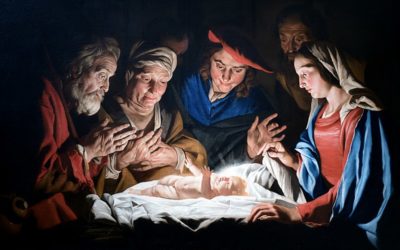When Oliver Cowdery and his companions went on their mission to the Lamanites, they hoped to convert Native peoples they might meet. Although the mission did not succeed in the way they expected, it proved to be greatly successful in another way, leading to a change in the Church’s headquarters and to the conversion of important future leaders.
Doctrine and Covenants 37
Because the mission was successful in teaching Sidney Rigdon, Edward Partridge, and many other restorationists in Ohio, the number of Church members in that state grew considerably. Meanwhile, opposition to the Church in New York continued, making it a difficult place for Church members to live.
Sidney and Edward went to visit Joseph Smith in New York. On December 30, 1830, not long after they arrived, Joseph received the revelation that is today section 37 of the Doctrine and Covenants. The revelation commanded that the Saints “assemble together at the Ohio, against the time that my servant Oliver Cowdery shall return unto them” (verse 3).
Three months earlier in the revelation that is now section 29 of the Doctrine and Covenants, the Lord related a decree “from the Father” that the elect “shall be gathered in unto one place upon the face of this land, to prepare their hearts and be prepared in all things against the day when tribulation and desolation are sent forth upon the wicked” (verse 8). Section 37 now clarified where they should gather.
Interestingly, this commandment was given before Oliver and his companions had even reached Missouri. On the day the revelation was received, the missionaries were pinned down by a fierce winter storm in Illinois about twenty miles from St. Louis, probably Columbia in Monroe County.
God knew what the results of their mission would be before they reached their final destination, and He went ahead and gave a commandment that capitalized on the missionaries’ success in Ohio.
To prepare for the move to Ohio, Joseph was commanded in section 37 to put his new translation of the Bible on hold (verse 1) and spend his time instead preaching the gospel and strengthening “the church whithersoever it is found, and more especially in Colesville,” New York, where the members of the branch were praying to God “in much faith” (verse 2).
Joseph was to help prepare the Saints for the next step in the Church’s progress, gathering to Ohio, something that required not just spiritual sacrifice from members but physical sacrifice as well in the form of giving up homes and farms to move like the children of Israel to a new land.
Section 29 of the Doctrine and Covenants had made it clear that to God, all things are spiritual. But in the new country of the United States, the idea that a spiritual leader could require a temporal sacrifice seemed out of bounds to some. Section 37 made it clear that those who gathered to Ohio must make a personal choice to do so. “Let every man choose for himself,” the Lord said, “until I come” (verse 4).
For more on the background of this section, click here.
Doctrine and Covenants 38
Three days after section 37 was received, the Saints met in conference at Fayette, New York. The Church had been organized less than nine months, but its members were ready to pull up stakes and move to Ohio as commanded in the recent revelation. On January 2, 1831, the day of the conference, Church members were eager for additional details about the impending move. According to John Whitmer’s history, “the Seer enquired of the Lord in the presence of the whole congregation, and thus came the word of the Lord.”
The revelation Joseph received is now section 38 of the Doctrine and Covenants. In it, the Lord explained that He knew and saw everything (verses 1–2). “I am in your midst and ye cannot see me,” the Lord said. “But the day soon cometh that ye shall see me, and know that I am; for the veil of darkness shall soon be rent, and he that is not purified shall not abide the day.” (Verses 7–8.)
The Lord told the Saints of a plan “had in secret chambers, to bring to pass even your destruction in process of time” (verse 13). “And again, I say unto you that the enemy in the secret chambers seeketh your lives” (verse 28).
“And that ye might escape the power of the enemy, and be gathered unto me a righteous people, without spot and blameless—Wherefore, for this cause I gave unto you the commandment that ye should go to the Ohio” (verses 31–32).
But safety was not the only blessing in obeying this commandment. The devout Saints would go to the Ohio, “and there,” the Lord promised, “I will give unto you my law; and there you shall be endowed with power from on high” (verse 32).
Once they had the law and were endowed, “whosoever I will shall go forth among all nations, and it shall be told them what they shall do; for I have a great work laid up in store, for Israel shall be saved, and I will lead them whithersoever I will, and no power shall stay my hand” (verse 33). In other words, the Saints would gather to Ohio, be prepared to do missionary work, and then go out to preach the gospel and gather in the elect to wherever the Lord designated.
Today when Latter-day Saints think of early pioneers moving to a Church gathering place, they often think of the 1847 trek to Utah. But other important pioneer journeys preceded that one. The first was the pioneer trip by land and water to the Ohio. The wealthy members would sacrifice greatly in the move. The poor members could not move without help. This would be true in future moves as well.
The Lord would provide a way for the poor. “And now, I give unto the church in these parts a commandment, that certain men among them shall be appointed, and they shall be appointed by the voice of the church; and they shall look to the poor and the needy, and administer to their relief that they shall not suffer; and send them forth to the place which I have commanded them” (verses 34–35).
And what about the rich? The Lord had counsel for them too. “They that have farms that cannot be sold, let them be left or rented as seemeth them good,” He commanded (verse 37). After the Saints had been endowed in Ohio, there would be time to liquidate the unsold farms (verse 38).
As for the pursuit of riches, the Lord added a promise and a caution. “And if ye seek the riches which it is the will of the Father to give unto you, ye shall be the richest of all people, for ye shall have the riches of eternity; and it must needs be that the riches of the earth are mine to give; but beware of pride, lest ye become as the Nephites of old” (verse 39).
For additional background on this section, click here.
Doctrine and Covenants 39
The revelation that is now section 39 of the Doctrine and Covenants was given on January 5, 1831, in Fayette, New York, in response to a promise by a Protestant minister “that he would obey any commandment that the Lord would give through his servent Joseph.” The precise identity of the minister is not known, though there are two major candidates, one a Baptist, the other a Methodist, with similar names.
In the revelation, the Lord taught the minister the first principles and ordinances of the gospel (verses 5–6), commended him for his present sincerity (verse 8), but pointed out that he had in the past been caught up in “pride and the cares of the world” (verse 9). If he now submitted to baptism and received the Spirit, the Lord promised, he would receive “a blessing so great as you never have known” (verse 10). The Lord would then put him to work preaching “the fulness of my gospel, which I have sent forth in these last days, the covenant which I have sent forth to recover my people, which are of the house of Israel” (verse 11).
Once baptized, the minister was to go to Ohio, where the Saints were commanded to gather. There, the Lord explained, “I have kept in store a blessing such as is not known among the children of men, and it shall be poured forth upon their heads. And from thence men shall go forth into all nations” (verses 14–15).
For more on the background of this section, click here.
Doctrine and Covenants 40
Despite the promises of the Lord to the Protestant minister in section 39 of the Doctrine and Covenants, the minister left the next day without doing as the Lord commanded him. The revelation that is now section 40 of the Doctrine and Covenants was given to Joseph Smith and Sidney Rigdon as an explanation about what happened to the minister.
The Lord explained that the minister’s heart was in the right place when he asked for a revelation, but it quickly changed. The Lord referred to His New Testament parable in which someone received the word but was choked by the thorns of worldly care and riches (Matthew 13).
In section 40, the Lord explained that the minister “received the word with gladness, but straightway Satan tempted him; and the fear of persecution and the cares of the world caused him to reject the word” (verse 2). Because the minister had covenanted to do whatever the Lord asked, his rejection of the word was especially grievous.
“Wherefore,” the Lord said, “he broke my covenant, and it remaineth with me to do with him as seemeth me good” (verse 3).
The minister might have done great good in the Church but instead walked away, missing the greatest opportunities of his life.
(Photo credit for image at top of page: Parley P. Pratt, one of the missionaries to the Lamanites, whose work helped convert Sidney Rigdon and others in Ohio. Public Domain. Copied from https://upload.wikimedia.org/wikipedia/commons/a/a9/Parley_P_Pratt.gif [accessed April 7, 2021]).



